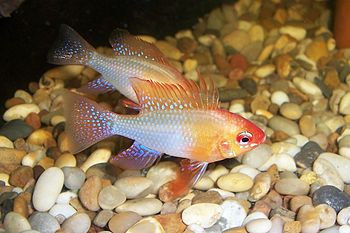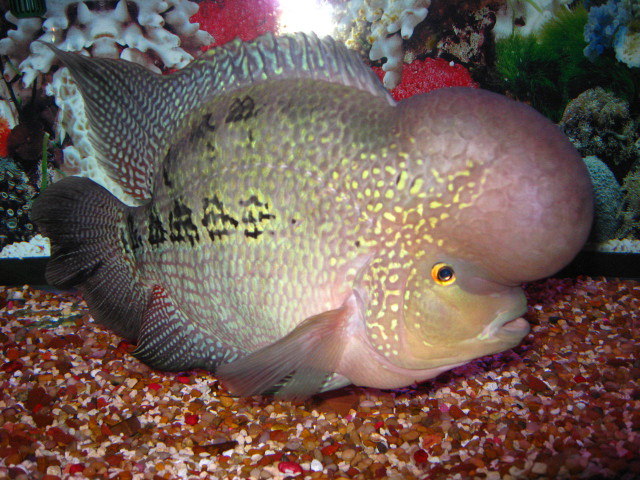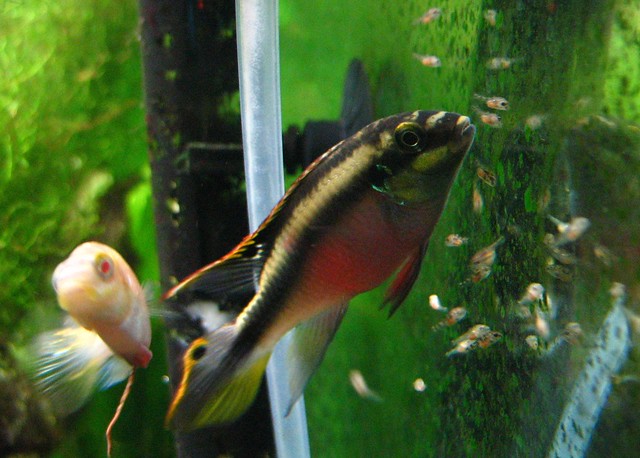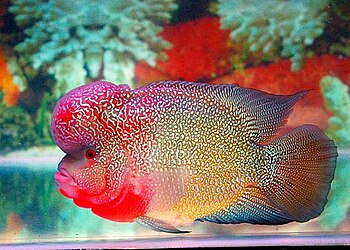 |
| Kribensis, male (Photo credit: Wikipedia) |
Kribs are very popular among freshwater aquarists because of their almost saltwater quality coloration.
Unlike most African cichlids, kribs have a temperament conducive to community living. They will adapt better to a community tank if given plenty of plants, rocks and hollow aquarium decorations to hide in.
Kribs thrive in soft to medium hard water with a pH level between 6.5-7.0 and a temperature range of 75-82°. They are a medium sized fish reaching three to four inches in length as adults and have an average lifespan of five years.
Kribensis are omnivores. They eat worms, insects, small crustaceans and plants in their natural habitat. In captivity, they are just fine on common variety tropical fish flakes.
Distinguishing males from females is easy. The males are larger than the females. Unlike most tropical fish, it is the female who has the more vibrant color palette.
Breeding Kribensis
Feeding them a diet high in protein such as brine shrimp, tubifex or bloodworms will help induce the spawning cycle. Privacy is essential to spawning. Kribs will seek out caves or hollow aquarium decor to spawn in.
The eggs will be deposited on the roof of their mating chamber. Spawning is complete when the male leave the spawning chamber. Sometimes males will become aggressive toward the female after spawning takes place. If this happens the male should be removed from the tank. If it does not he may be left with the female.
The female will stay in the chamber until the eggs hatch. This will occur in 36-48 hours. It is not uncommon for both adults to guard over the eggs until they hatch.
In 3-4 days the fry will be free swimming. Both parents will demonstrate parental instincts toward their newly hatched offspring. They will herd the brood around the tank keeping a watchful eye on them. There are rare occasions when adult kribs have been reported to eat the fry once they are free swimming. This is not common. You can play it safe by removing the adults if you choose.
A report issued by Barlow in the year 2000 stated that fry raised in an acidic environment will be mostly male. A neutral or slightly alkaline content will result in a heavier female population. I found this information one of the more interesting facts I came across while researching this cichlid.
Free swimming fry can be fed liquid fry food available at most fish stores. A suitable alternative to store bought food is powdered eggs. Add it sparingly to avoid fouling the water. Fry are small. They don't eat much.
Freshwater fish are the most popular aquarium fish worldwide because of their inexpensive price and ease of care. Many aquarium owners don't realize that there is a rather exotic alternative to freshwater fish in the realms of affordability and upkeep. Jellyfish aquariums are the hottest new trend in the aquarium industry. Jellyfish do require a special Jellyfish Aquarium Fish Tank in order to survive but they are far easier to keep alive and healthy than saltwater fish. If you find the idea of raising pet jellyfish intriguing, find out more about Moon Jellyfish and other Pet Jellies.
Article Source: EzineArticles
|













